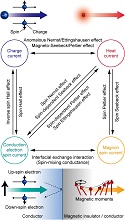Volume 64, Issue 12
Special Feature : Energy Conversion and Transport at Interfaces
Displaying 1-10 of 10 articles from this issue
- |<
- <
- 1
- >
- >|
Preface
-
Article type: Preface
2021Volume 64Issue 12 Pages 539
Published: December 10, 2021
Released on J-STAGE: December 10, 2021
Download PDF (396K)
Special Feature : Energy Conversion and Transport at Interfaces
-
Article type: Introduction
2021Volume 64Issue 12 Pages 540-541
Published: December 10, 2021
Released on J-STAGE: December 10, 2021
Download PDF (270K) -
Article type: Current Topics
2021Volume 64Issue 12 Pages 542-547
Published: December 10, 2021
Released on J-STAGE: December 10, 2021
Download PDF (2809K) -
Article type: Current Topics
2021Volume 64Issue 12 Pages 548-551
Published: December 10, 2021
Released on J-STAGE: December 10, 2021
Download PDF (4095K) -
Article type: Current Topics
2021Volume 64Issue 12 Pages 552-555
Published: December 10, 2021
Released on J-STAGE: December 10, 2021
Download PDF (3037K) -
 Article type: Current Topics
Article type: Current Topics
2021Volume 64Issue 12 Pages 556-561
Published: December 10, 2021
Released on J-STAGE: December 10, 2021
Download PDF (4961K) -
Article type: Current Topics
2021Volume 64Issue 12 Pages 562-567
Published: December 10, 2021
Released on J-STAGE: December 10, 2021
Download PDF (1301K)
Current Topic
-
Article type: Current Topics
2021Volume 64Issue 12 Pages 568-574
Published: December 10, 2021
Released on J-STAGE: December 10, 2021
Download PDF (5133K)
Report
Conference Report
-
Article type: Report
2021Volume 64Issue 12 Pages 575
Published: December 10, 2021
Released on J-STAGE: December 10, 2021
Download PDF (269K)
News & Trends
-
Article type: News & Trends
2021Volume 64Issue 12 Pages 576
Published: December 10, 2021
Released on J-STAGE: December 10, 2021
Download PDF (334K)
- |<
- <
- 1
- >
- >|






